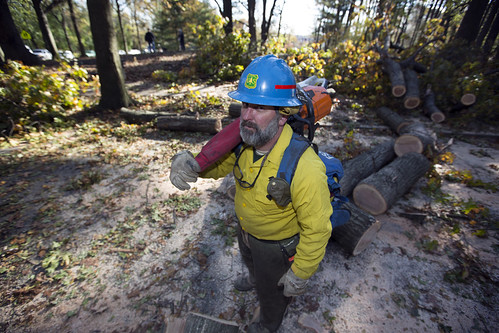
All this week, Americans are pausing to reflect on the devastation caused when Hurricane Sandy slammed ashore on the eastern seaboard. Over 160 people died, property was damaged, lives were disrupted, families were torn apart and jobs were affected.
USDA helped the recovery effort in a number of ways, and while we are proud of our work, we also learned from the experience in order to assist those affected by future catastrophes.
Our first task was helping those who were facing hunger. Following a disaster, the USDA Food and Nutrition Service (FNS) provides nutrition assistance to disaster survivors through disaster USDA Foods Distribution Programs and by authorizing the implementation of the Disaster Supplemental Nutrition Assistance Program (D SNAP). In addition, FNS approves waivers that simplify the SNAP benefit replacement process to aid ongoing SNAP households affected by a disaster.
Hurricane Sandy affected the area from Florida to Maine, causing extensive flooding, leaving more than 8.5 million customers without power, and contributing to severe fuel shortages in parts of New Jersey and New York. The storm damaged or destroyed hundreds of thousands of homes. In total, 24 counties in three states issued over $5.7 million in D-SNAP benefits to over 12,000 households, and almost 242,000 SNAP households received over $38 million in automatic supplemental benefits.
Seven states issued over $115 million mass SNAP replacement benefits to over 1 million affected households; and two States received hot foods waivers. In addition, over 1.1 million pounds of USDA Foods worth $1.7 million was provided to meet congregate and household nutrition assistance needs in New York and New Jersey, and an estimated $14 million in free meals were provided through the National School Lunch and Breakfast Programs. We did it all with the help of our private and governmental partners.
Large numbers of trees fell, wires toppled, communications were disrupted. The Forest Service mobilized. At the height of the hurricane response effort, approximately 1,200 interagency firefighters organized by the U.S. Forest Service were sent to the impacted areas to provide assistance to communities in need. Afterward, the Natural Resources Conservation Service moved in to assist five states through the Emergency Watershed Protection Program. Debris were removed from waterways, and now the NRCS is working to process applications for floodplain easements to ensure that the effects of future storms are minimized.
The USDA Animal and Plant Health Inspection Service’s (APHIS) Animal Care (AC) program supported FEMA operations at the National Response Coordination Center in Washington, D.C., following Sandy. APHIS AC helped to connect animal response organizations to FEMA resources. It was the first time APHIS Animal Care assisted in the mobilization of resources in response to state requests.
APHIS also staffed FEMA's National Response Coordination Center (NRCC) in conjunction with its partners at the National Alliance of State Animal and Agriculture Emergency Programs (or NASAAEP) and the National Animal Rescue Sheltering Coalition (or NARSC) to facilitate private organizations' support of people in disasters. For example, PetSmart Charities worked on behalf of NARSC to set up distribution centers in three states to coordinate distribution of pet food and two members of the APHIS Animal Care Program Response team were deployed in advance of Sandy’s landfall to prepare to assist pet owners and owners of production animals.
These are just a few of the many examples of efforts undertaken by USDA employees to assist those in need. In times of disaster, USDA is ready to help. Read more about our emergency preparedness and response efforts here.
To learn more about government-wide efforts to assist in the recovery from Hurricane Sandy click here.
